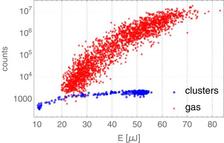Excited noble-gas clusters stimulate lasing emission in the forward direction. (Credit: Original publication in Phys. Rev. A (2020))
An international team of scientists, headed by Nina Rohringer from DESY and Unversität Hamburg, has succeeded in getting bursts of laser-like extreme ultraviolet (XUV) emission from noble-gas clusters in the transient warm dense matter state. Xenon clusters were irradiated by DESY’s free-electron laser FLASH, and the resulting strongly amplified fluorescence signal was analysed by a high-resolution spectrometer. Theoretical modeling of the process indicates that the clusters, transformed to a nanometer-sized plasma (‘nanoplasma’), enable the creation of population inversion by means of electron-ion collisions. The transient but sizeable population inversion of the ensemble of clusters enables amplification of spontaneous emission in a single pass of the emitted XUV radiation. This study, performed at the CAMP station of the FLASH beamline BL1 at DESY, is published in Physical Review A and is highlighted as an Editors’ Suggestion.
Lasers for visible wavelengths are the core components of numerous modern technologies and scientific instrumentations. Ever since their invention in the 60s the push towards even shorter wavelengths in order to develop X-ray lasers was a dream for many scientists. A direct transfer of the ‘table top’ laser technique from the visible to the X-ray spectral domain is not possible due to the extreme high power densities that are needed to pump transitions involving inner electronic shells. The situation changed with the advent of X-ray free-electron lasers (XFELs) that can serve as a high-intensity pump enabling strongly amplified emission on transitions involving the inner-most electronic shell. Successful amplification, even more saturation of amplification was so far reached in gas, solid and liquid targets in the soft and hard X-ray spectral region. However, adopting similar concepts to the XUV, the frequency range between X-rays and ultraviolet light, faces difficulties: Due to the so-called Auger effect, corresponding electronic transitions release energy predominantly by an energetic electron rather than an XUV photon.
In a preceding study, the team of scientists used short radiation bursts from FLASH to ionise Xenon (Xe) gas. The subsequent relaxation of the highly excited noble-gas ions resulted in establishing population inversion between states of the doubly-ionised Xe ion. This population inversion supported the amplification of fluorescent XUV light and generated short, directed and laser-like radiation – so-called superfluorescence. Similar experiments in solid Xe did, however, not show such an effect. Nanometer-sized clusters, with several hundred atoms, are objects that fill the niche between atomic and solid-state systems. After irradiation by light pulses from FLASH, massive ionisation of a cluster causes the creation of a nanometer-sized plasma. This nanoplasma expands rapidly. During this explosion, the cluster passes through an exotic state called warm dense matter (WDM). In such a state, a large number of energetic electrons are captured within the nanoplasma and undergo numerous collisions with the plasma ions, thereby essentially changing their radiative properties.
Theoretical modeling shows that these electron-ion collisions in WDM have a two-fold influence. First, collisions result in strong decoherence and quenching of the amplification, which was experimentally observed as an increase of emission linewidth and a strong decrease of the emission yield. This is in strong contrast to gas-phase targets resulting in quasi isolated ions that do not undergoe decoherence by electron collisions. Second, collisions enhance the formation of a population inversion that can outcompete losses due to decoherence effects. The observed, relatively high photon yields can only be explained by an extended time duration during which population inversion exists. After a comparison of the experimental results with a theoretical model, the team of scientists concludes that collisions in the nano-plasma are critical to build up and sustain population inversion in the system. The theoretical model accounts for the spatial and temporal evolution of the clusters, the radiation transfer, and collective emission and amplification.
“Unlike traditional table top XUV and soft X-ray lasers that typically involve a hot, dense plasma enabling radiative transitions within highly charged ions, here we observed lasing in low charge states. In this field, strong focus lies on the laser target design: structured targets on the nanoscale can exhibit enhanced emission features.” explains Nina Rohringer, she is leading scientist at DESY and professor at the Universität Hamburg, “The understanding of the evolution and gain characteristics of such plasma targets is crucial to engineer novel table-top XUV sources. Our detailed study on amplified spontaneous emission and plasma evolution in nanometer sized clusters directly connects to this wider range of activities.”
Reference:
Amplified spontaneous emission in the extreme ultraviolet by expanding xenon clusters; A. Benediktovitch, L. Mercadier, O. Peyrusse, A. Przystawik, T. Laarmann, B. Langbehn, C. Bomme, B. Erk, J. Correa, C. Mossé, D. Rolles, S. Toleikis, M. Bucher, C. F. O. Bostedt, A. Sanchez-Gonzalez, S. Dobrodey, M. A. Blessenohl, A. Nelde, M. Müller, D. Rupp, T. Möller , J. R. Crespo López-Urrutia, and N. Rohringer; Phys. Rev. A, 2020 (Editors’ Suggestion); DOI: 10.1103/PhysRevA.101.063412
The research project was funded, among other sources, by the Federal Ministry of Education and Research (BMBF) that supported the installation of CAMP@FLASH end-station where the experiments were performed. In experiments, modeling and analysis were involved scientists from DESY, European XFEL in Hamburg, Aix-Marseille Université in France, Technische Universität Berlin, Max-Plank-Institut für Kernphysik in Heidelberg, Imperial College London in UK, Kansas State University, SLAC National Accelerator Laboratory, Argonne National Laboratory in US, and ETH Zurich in Switzerland.








